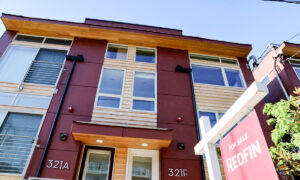
Homes taking longer to sell while mortgage rates remaining persistently high point to signs of a housing market recession
The U.S. housing market continued to show signs of decline as mortgage applications and sales of existing homes fell while properties are taking longer to get sold.
Mortgage applications for new home purchases dropped by 11 percent in April 2023 compared to March, according to a Mortgage Bankers Association May 19 press release. “Since the brief pick-up in new home sales in January when mortgage rates dipped, the pace of new home sales has declined for the three consecutive months,” said Joel Kan, MBA’s vice president and deputy chief economist.
Declining mortgage demand comes as the Conference Board’s Leading Economic Index (LEI) fell for the thirteenth consecutive month in April, signaling that the country is potentially headed toward a recession or may already be in one.
Applications for mortgages have dropped amid a decline in existing-home sales. Based on data from the National Association of Realtors (NAR), total existing-home sales fell 3.4 percent from March to 4.28 million in April 2023. On a year-over-year basis, sales fell 23.2 percent.
“Home sales are bouncing back and forth,” said NAR Chief Economist Lawrence Yun, said a recent news release. “The combination of job gains, limited inventory, and fluctuating mortgage rates over the last several months have created an environment of push-pull housing demand.”
Homes are also taking longer to be sold. Properties usually remained on the market for 22 days in April 2023, up from 17 days a year back. Unsold inventory stood at 2.9 months of supply in April 2023 at the current pace of sales, which is up from 2.2 months in April 2022.
High Home Ownership Costs
The declining sales of existing homes and mortgage applications are happening as mortgage rates remain elevated. The average rate on a 30-year fixed-rate mortgage was 6.39 percent for the week ending May 17, up from 3 percent just two years back.
Meanwhile, home prices also remain at unaffordable levels for many people. A U.S. Home Affordability Report issued by ATTOM, a curator of real estate data, shows that median-priced single-family homes and condos were less affordable in the first quarter of this year compared to the historical averages in 94 percent of American counties.
This is a big jump compared to last year. In the first quarter of 2022, only 62 percent of counties had homes that were less affordable than the historical averages.
High home prices and elevated mortgage rates mean that buying a house makes no more financial sense to many people. According to real estate brokerage Redfin, purchasing a home is cheaper than renting only in four out of the 50 most popular metros.
On average, Redfin calculates that a typical home costs 25 percent more to buy than rent in these metros, with an estimated monthly mortgage payment of $3,385 compared to an estimated rent of $2,715.
Mortgage Rates, Recession
Redfin Deputy Chief Economist Taylor Marr pointed out that mortgage rates will likely fall below 6 percent by year-end but are unlikely to get back to the 3 percent level anytime soon.
“I wouldn’t encourage people to squeeze their budgets in order to buy a home when prices are falling and we’re teetering on a recession,” Marr said, according to a May 19 press release.
“In the years leading up to the pandemic, it made sense for some homebuyers to break the rule that says not to spend more than 30 percent of your income on monthly housing costs, but these times are more risky, so it makes sense to be a little more conservative.”
Signs of the American economy heading into a recession have strengthened, with the Conference Board’s Leading Economic Index (LEI) falling for the thirteenth consecutive month in April. LEI provides an early indication of significant turning points in the business cycle and where the economy is heading in the near term.
LEI provides an early indication of significant turning points in the business cycle and where the economy is heading in the near term.
“The LEI continues to warn of an economic downturn this year. The Conference Board forecasts a contraction of economic activity starting in Q2 leading to a mild recession by mid-2023,” said Justyna Zabinska-La Monica, a senior manager at The Conference Board.
A probability model from the New York Federal Reserve calculates the risk of the United States slipping into a recession within the next year at 68.2 percent, the highest level since 1982.
The indicator’s value is now greater than it was in November 2007 before the subprime crisis when the probability of recession was just 40 percent.

















































